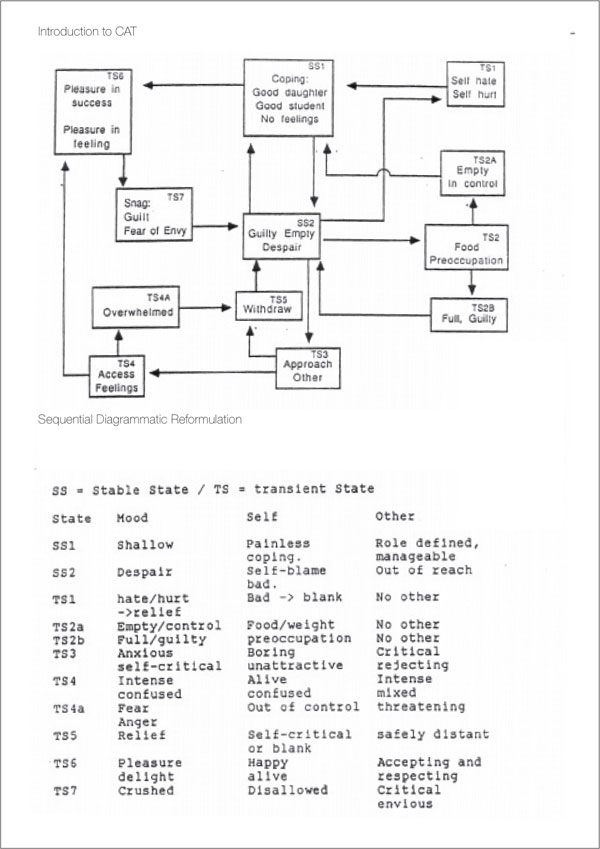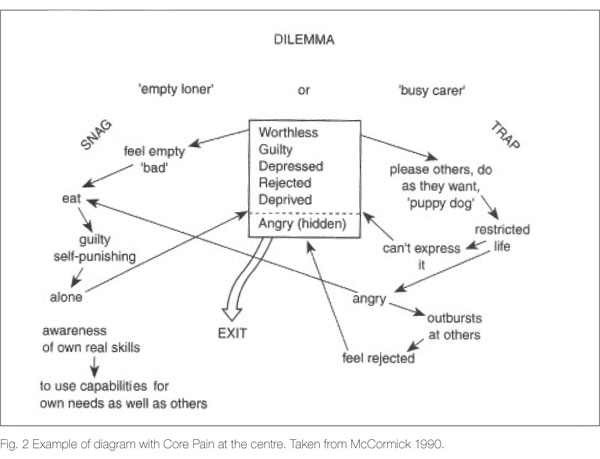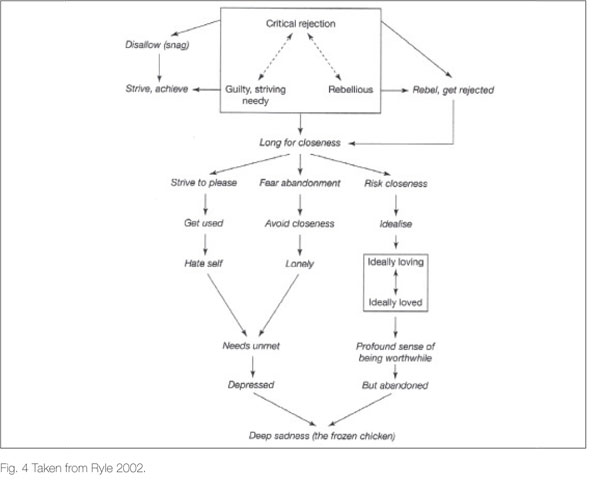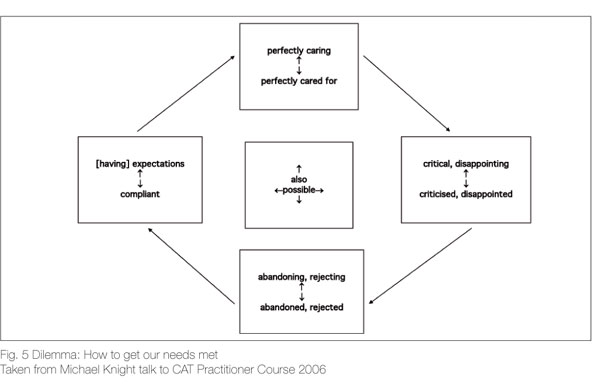Web-site restrictions
ACAT is moving to a new website shortly. Due to unforeseen technical issues, the launch has been postponed briefly until Tuesday, 6th May.
In preparation, this website no longer lets members renew their membership. ACAT Administration are likewise unable to process membership renewals until the new site opens.
Please do not update any personal details on your member/friend profile, as changes at this point will not be transferred to the new site.
Thank you for your patience, and we look forward to welcoming you to a new website after the Early May bank holiday.
The Development of the Sequential Diagrammatic Reformulation
Parkinson, R., 2008. The Development of the Sequential Diagrammatic Reformulation. Reformulation, Summer, pp.33-37.
I am currently in the second year of the Oxford CAT Practitioner course and have always found constructing the sequential diagrammatic reformulation (SDR) to be something of a challenge. I decided I wanted to find out what the theory was and how to link this to my practice. What I have ended up compiling is a short history of the SDR.
CAT is still quite a young therapy and is developing all the time. In my research for this article I discovered that much of this development must have happened outside the publication of the main text books. Assumptions about how CAT is done change between these publications over time but often without explanation of that change process.
The role and construction of the SDR seems to be one of the key areas where development has taken place at the coal face and is reflected in assumptions made in the text books.
I apologise for the assumptions in your knowledge that I will have to take in this whistle stop tour of the diagram through the ages. In fact I need to take for granted your knowledge of the Procedural Sequence Model (PSM) and the Procedural Sequence Object Relations Model (PSORM), traps, dilemmas, snags and reciprocal roles (RRs).
In the beginning…
In 1986 when Ryle published a booklet entitled ‘An Introduction to Cognitive-Analytic Therapy’ the letter was seen as the key part of reformulation. In 1986 Ryle was writing that “in some instances, particularly in cases of personality disorder, the prose reformulation needs to be supplemented with a sequential diagrammatic reformulation or SDR.” (Ryle, 1986) (see Fig. 1).
In these diagrams there was a core state of negative feelings (here guilty, empty and despair). There would then be a dominant but unsatisfying social or interpersonal mode (here good daughter, good student) and often, symptomatic sequences (here food preoccupation). At this time Ryle talked about linking these up in a sequence to demonstrate how they only served to maintain the core state: a problem solving circle that always returns to the place it started. At this stage this was the core state but as the PSORM became more used than the PSM, the core became the reciprocal roles. (As early as 1985 Ryle had added object relations into the PSM and produced the PSORM. The reciprocal role concept enabled transference and countertransference to be linked to the diagram). From the RRs would emanate either a circular trap: a procedure arising from and returning to the RRs, confirming the client’s beliefs about self and others; a dilemma: two polarised procedural traps that arose from and ended in the same RRs; or a snag, a truncated procedure ending in self-sabotage.
The next step
When Ryle published his first book: Cognitive-Analytic Therapy: Active Participation in Change in 1989 he described the reformulation process as including two parts: the letter and the list of TPs and TPPs. At no point in this part of the book does he mention diagrams. Once again, however, when talking about complex reformulation with personality disordered clients he sees a need for a more conceptual framework and brings in the ideas of diagram reformulation and of reciprocal role procedures. He says that in these cases “a sequential diagrammatic reformulation developed at the start of therapy represents a precise and powerful tool guiding the therapist in his interventions and offering to the patient a basis for a fuller control and integration of the self.” (Ryle 1989)
In Elizabeth McCormick’s book Change for the Better, originally published in 1990, she has a whole chapter on making a diagram for yourself of your inner conflict. All of these require us to identify our core state pain and place this at the centre of our diagrams. (see Fig. 2) (I have not found reference to core pain in Ryle’s work except when he talks about how unhelpful a term it is.)
However, as early as 1979 Horowitz was talking about different states in those with Borderline Personality Disorder (BPD) (Horowitz 1979) and in 1990 Ryle published a paper discussing the use of the SDR to show in a clearer way the patient’s state shifts. I’ll just jump ahead a bit to show the development of the BPD diagram. In Ryle’s 1997 book on CAT and BPD (Ryle, 1997), the self-state diagram for BPD had clearly been chosen as the most helpful form for those with this disorder and for those caring for or treating them in a team setting. (see Fig. 3)
Coming back to CAT for the non-BPD client, Ryle (1989) and McCormick (1990) mention inclusion of RRs in diagrams, although they are not the key ideas in diagram formation. In between their publications and the publication of the current definitive guide to CAT in 2002, RRs and the SDR had come to take on a much more important role.
The development of the official line
In 1998 Ryle contributed a short paper to Reformulation in which he described how to construct an SDR and said he was “revising priorities” (Ryle, 1998). His key theme was to think reciprocally from the start and construct the diagram around the identified RRs.
In the current definitive guide: Introducing Cognitive Analytic Therapy: Principles and Practice (no hyphen now), Chapter 6 begins by saying: “The early sessions of CAT focus on the joint creation of written and diagrammatic descriptive reformulations...” (Ryle, 2002).
By now the diagrams were focussing on the PSORM of which the key concept was reciprocal role procedures (RRPs). Indeed Ryle says the SDR “sets out to describe the core reciprocal role repertoire” (Ryle 1998). It is now these RRPs which are placed at the centre of the diagram and not the core state of negative feelings. Procedures are then drawn as loops coming out and usually returning to the core of the diagram. (see Fig.4)
The development at the coal-face
Of course over all this time there has been other input. Some discussion about the priorities in constructing diagrams has made its way into the pages of Refomulation:
1997 - Annie Nehmad’s article on borderline core states and RRPs as self-states in which she included a plea for the SDR to include the healthy RRPs.
1998 - Cherry Boa’s article pleading for a return to a simple easily taught diagram
2000 - Michele Fitzsimmons’ suggestion of a credit card sized SDR which would be produced by the therapist so the client could carry it around easily.
Of course much more has been going on. Supervisors, courses, seminar leaders, conferences and individual practitioners have all been developing the ideas of CAT. As a student this means that the message on how to construct diagrams is often confusing and sometimes contradictory.
The future?
In the last few years Michael Knight has developed a clock-face style diagram which is a much simpler way of including all the elements of a diagram and can be easily understood by clients. Alison Jenaway mentioned some of his ideas in the last issue of Reformulation (Jenaway, 2007) but to date as far as I am aware Knight has not published his ideas himself. I include below an example of format of his diagrams as I understand them (see Fig 5). Perhaps Knight himself might be able to elaborate in the next issue of Reformulation?
Conclusion
It is clear as I said at the beginning that CAT is evolving all the time. I certainly understand better now why I’m doing what I’m doing when I construct a diagram than I did before I began this research. I wonder if this could be made clearer in training? If this history was made more explicit we all might have a better understanding and therefore a better springboard to begin constructing diagrams for our clients.
References
Boa, Cherry, (1998) - SDRs for beginners. ACAT Reference Library. www.acat.me.uk/article.php?article_id=229
Fitzsimmons, Michele, (2000) - A credit-sized SDR and its use with a patient with limited language skills. ACAT Reference Library. www.acat.me.uk/article.php?article¬_id=64
Horowitz, M. J., (1979) - States of Mind. New York: Plenum Press
Jenaway, Alison, (2007) - Using Cognitive Analytic Therapy with parents: some theory and a case report. Reformulation 29, Winter 2007
McCormick, Elizabeth Wilde, (1990) - Change for the Better. Self-help through practical psychotherapy. London: Cassell
Nehmad, Annie (1997) - The Essence of Effective Psychotherapy. Reflections of a CAT therapist learning Solution Focussed Brief Therapy. www.acat.me.uk/article/371
Ryle, Anthony, (1986) - An Introduction to Cognitive-Analytic Therapy (CAT) booklet
Ryle, Anthony, (1989) - Cognitive-Analytic Therapy: Active Participation in Change: A New Integration in Brief Psychotherapy. Chichester: John Wiley and Sons, Ltd.
Ryle, Anthony (1997) - Cognitive Analytic Therapy and Borderline Personality Disorder. The Model and the Method. Chichester: John Wiley & Sons Ltd.
Ryle, Anthony, (1998) - Sequential Diagrams, Reflections and Suggested Revisions. ACAT Newsletter 10
Ryle, Anthony and Kerr, Ian B., (2002) – Introducing Cognitive Analytic Therapy Principles and Practice. Chichester: John Wiley and Sons, Ltd.







Full Reference
Parkinson, R., 2008. The Development of the Sequential Diagrammatic Reformulation. Reformulation, Summer, pp.33-37.Search the Bibliography
Type in your search terms. If you want to search for results that match ALL of your keywords you can list them with commas between them; e.g., "borderline,adolescent", which will bring back results that have BOTH keywords mentioned in the title or author data.
Related Articles
History and Use of the SDR
Ryle, A., 2003. History and Use of the SDR. Reformulation, Autumn, pp.18-21.
Sequential Diagrams, Reflections and Suggested Revisions
Ryle, A., 1998. Sequential Diagrams, Reflections and Suggested Revisions. Reformulation, ACAT News Autumn, p.x.
A Brief Introductory Handout About CAT
Blunden, J., 1993. A Brief Introductory Handout About CAT. Reformulation, ACAT News Winter, p.x.
States Characterisation Procedure (SCP) for supporting the reformulation of patients with borderline/dissociative features
Ryle, A., 2007. States Characterisation Procedure (SCP) for supporting the reformulation of patients with borderline/dissociative features. Reformulation, Winter, pp.9-11.
Early Signs of Dialogical Sequences in CAT
Leiman, M., 1997. Early Signs of Dialogical Sequences in CAT. Reformulation, ACAT News Winter, p.x.
Other Articles in the Same Issue
CAT Used Therapeutically and Contextually
Murphy, N., 2008. CAT Used Therapeutically and Contextually. Reformulation, Summer, pp.26-30.
Catch up with CAT
Potter, S., Curran, A., 2008. Catch up with CAT. Reformulation, Summer, p.54.
Clinical Implications for the Pregnant CAT Therapist
Knight, A., 2008. Clinical Implications for the Pregnant CAT Therapist. Reformulation, Summer, pp.38-41.
Consent to Publish in Reformulation
Jenaway, A., Lloyd, J., 2008. Consent to Publish in Reformulation. Reformulation, Summer, p.7.
Cuckoo Lane
Selix, M., 2008. Cuckoo Lane. Reformulation, Summer, p.6.
How to Enjoy Writing a Prose Reformulation
Wilde McCormick, E., 2008. How to Enjoy Writing a Prose Reformulation. Reformulation, Summer, pp.16-17.
Integration of Cognitive Analytic Therapy Understandings
Ruppert, M., Birchnall, Z., Bruton, C., Christianson, S., 2008. Integration of Cognitive Analytic Therapy Understandings. Reformulation, Summer, pp.20-22.
Is CAT an Island or Solar System?
Bancroft, A., Collins, S., Crowley, V., Harding, C., Kim, Y., Lloyd, J., Murphy, N., 2008. Is CAT an Island or Solar System?. Reformulation, Summer, pp.23-25.
Letter from the Chair of ACAT
Westacott, M., 2008. Letter from the Chair of ACAT. Reformulation, Summer, pp.3-4.
Letter from the Editors
Elia, I., Jenaway, A., 2008. Letter from the Editors. Reformulation, Summer, p.3.
Metaprocedures in Normal Development and in Therapy
Hayward, M., McCurrie, C., 2008. Metaprocedures in Normal Development and in Therapy. Reformulation, Summer, pp.42-45.
Plugging in and Letting Go: the Use of Art in CAT
Hughes, R., 2008. Plugging in and Letting Go: the Use of Art in CAT. Reformulation, Summer, pp.9-10.
Service Innovation
Jenaway, A., Mortlock, D., 2008. Service Innovation. Reformulation, Summer, pp.31-32.
Silence in Practice
Harvey, L., 2008. Silence in Practice. Reformulation, Summer, pp.11-13.
The ‘Human Givens’ Fast Trauma and Phobia Cure
Jenaway, A., 2008. The ‘Human Givens’ Fast Trauma and Phobia Cure. Reformulation, Summer, pp.14-15.
The Body in Dialogue
Burns-Lundgren, E., Walker, M., 2008. The Body in Dialogue. Reformulation, Summer, pp.18-19.
The Development of the Sequential Diagrammatic Reformulation
Parkinson, R., 2008. The Development of the Sequential Diagrammatic Reformulation. Reformulation, Summer, pp.33-37.
The States Description Procedure
Hubbuck, J., 2008. The States Description Procedure. Reformulation, Summer, pp.46-53.
Help
This site has recently been updated to be Mobile Friendly. We are working through the pages to check everything is working properly. If you spot a problem please email support@acat.me.uk and we'll look into it. Thank you.
